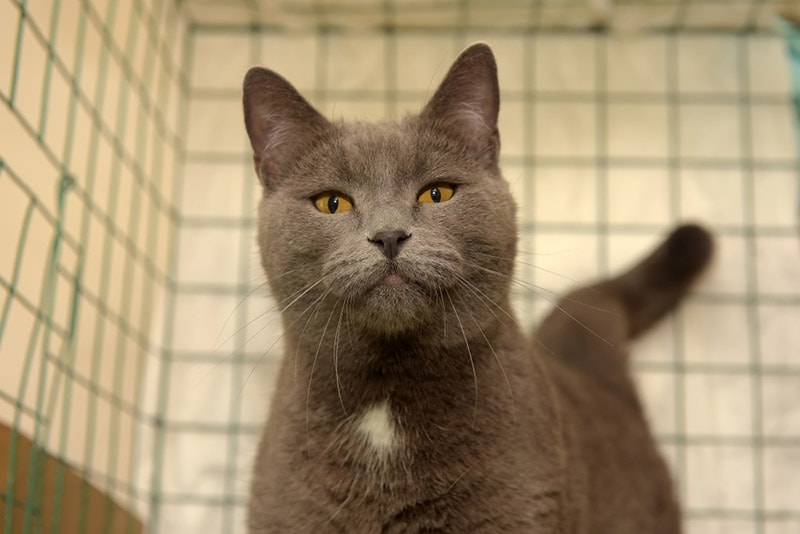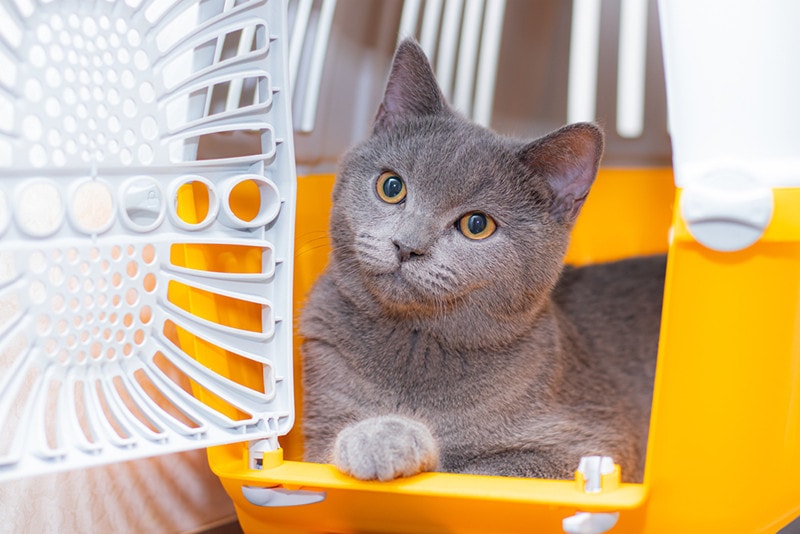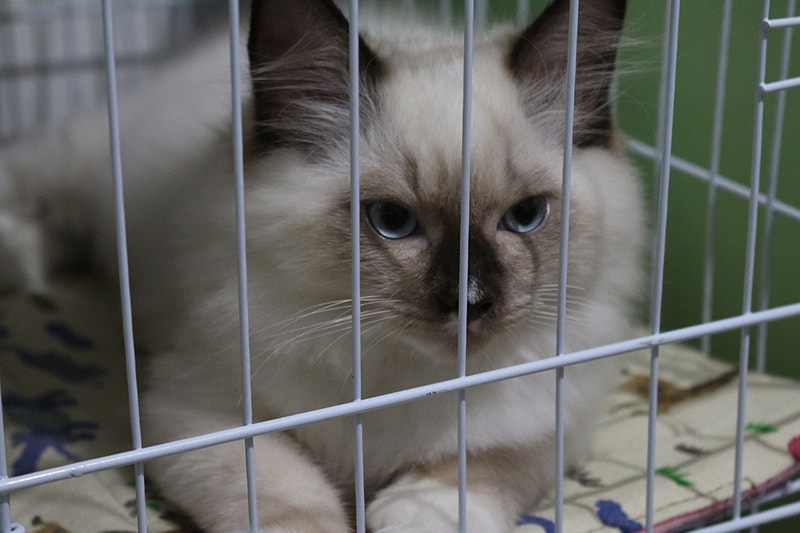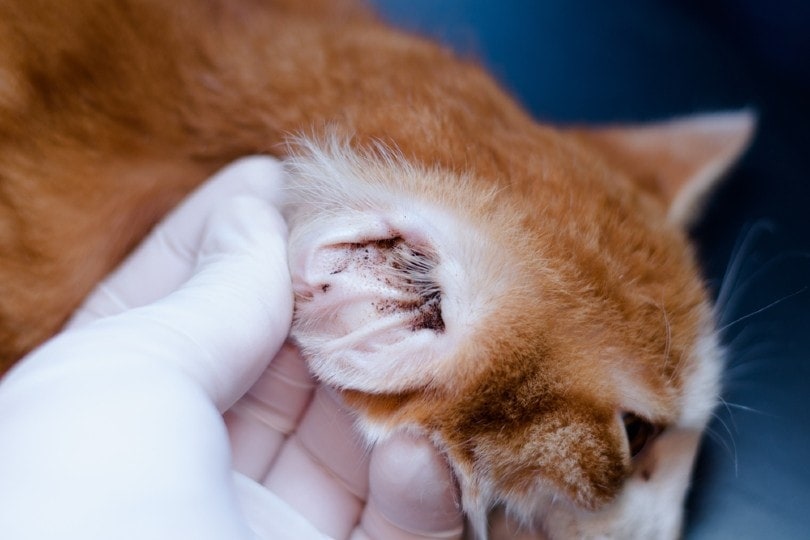Can You Crate a Cat at Night? Vet-Reviewed Facts & Safety Tips
By Jordyn Alger
Updated on

Click to Skip Ahead
If your cat keeps you up at night, you may be at your wit’s end trying to figure out how to get a decent night’s sleep. Crating your cat at night may have crossed your mind, but it is unhealthy for a cat to stay in a crate that long. The maximum time a crate-trained cat should spend in their crate is 6 hours. Most humans sleep more than 6 hours, so keeping your cat in a crate overnight is not a good idea. Your cat should have appropriate positive reinforcement crate training before you even consider keeping them in a crate for even just a few hours, as it may otherwise cause them significant stress.
Still, that doesn’t mean that cats cannot be put in crates at all, and it doesn’t mean that you have to say goodbye to a good night’s rest. In this article, we’ll discuss how to crate a cat and tips for reclaiming your sleep schedule.
Can You Crate a Cat?
Although crates are often used for dogs, they may also be acceptable for some cats if trained appropriately and from a young age. Cat crates are not the same as cat carriers, which transport your cat to and from different locations and are much smaller. They will only have the room to accommodate your cat and are made from plastic, wicker, or sturdy fabric. Instead, a cat crate is typically a stationary, larger enclosure that provides security and privacy for your cat.
When searching for a crate for your cat, you will need to keep your cat’s size in mind. A good crate will be big enough to allow your cat to comfortably stand, stretch, and turn around while also accommodating your cat’s litter box, giving your cat plenty of space to roam while still having their essentials on hand, such as fresh food, water, toys and, ideally, a smaller scratching post or pad.

Why Would a Cat Need to Stay in a Crate?
There are many reasons why a cat may need to stay in a crate. Therefore, remaining calm and feeling comfortable and secure while in a crate is an essential skill you should train your cat to develop. Otherwise, this may lead to a significant level of anxiety and stress for your cat, which is not good for their health or welfare.
Some examples of situations where crating your cat may be necessary include:
- When work or maintenance is being done inside your home
- If your cat needs to rest and recover after a surgery
- If your cat needs to stay at the vet hospital for treatment
- If emergency evacuation is ordered in your area
- Any time your cat needs a place to sleep, play, or relax undisturbed and they choose to use their crate
- If you are house training your new kitten and you are not available to supervise them at all times, as crate training will keep them safe from potential hazards in the home
- When you are introducing new pets
- When your cat is going to a boarding facility
- When you travel with your cat
Essentially, your cat’s crate is similar to a baby’s cradle. It is a safe and effective way to keep your cat in one place while giving them the privacy and security they need, but only if trained appropriately. Otherwise, a crate may be a source of stress and fear for your cat and should not be used.
How to Crate Train Your Cat
While crate training can begin at any age, training your cat earlier rather than later is easier.
Most pets can learn to remain calm and comfortable in a crate, enjoying the safety it provides alongside their food, treats, and toys, but if your cat expresses genuine distress and agitation, pause crate training and consult your vet or a feline behaviorist. Signs that your cat is truly distressed include incessant vocalization, drooling, vomiting, escape attempts, and urination or defecation outside of the litter box.
A crate should be their safe space; where they learn to expect a positive experience, such as tasty treats or new toys, and not a sign of stress.

Crate Training
Before you begin training your cat, ensure they are familiar with the crate by leaving it in the room for days or even weeks. Keep the door open with some tasty treats, a comfy bed, and fun toys inside. This may tempt your cat to explore it on their own terms and realize it’s a safe and fun place to be.
Always ensure you are providing adequate daily exercise for your cat, including mental stimulation. You can put the crate in a quiet area of the home to keep your cat calm and content.
To begin training, provide positive associations between your cat and the crate. An excellent way to do this is by giving them treats or feeding them their usual meal in the crate. You can also give your cat a special toy that only comes out during crate time. By doing that, your cat will learn that the crate is a safe, happy place rather than something to fear.
Let your cat explore the crate for several days or weeks and enjoy a treat with the door open. As your cat grows more accustomed to being in the crate, you can eventually close the door for a few minutes at a time and walk away. Your cat may continue to eat or play, which is fine. You can leave the room, but stay nearby so that you can hear your cat. Eventually, they should relax and possibly fall asleep. Also, spend some time in the same room while offering treats and just observing your cat. They may be fidgety at first but should settle quickly if they are comfortable in their crate. Provide a nice, soft bed or fleece blanket as well.
However, if your cat is distressed or is not settling down promptly, you may need to let them out and slow down the adjustment process by taking a step back. Don’t let them out on the very first instance of them scratching and trying to open the door, as you will teach them that this is a behavior that gets them out of the crate. This is normal and should only last a short time. But also, don’t ignore their unhappiness of being locked in. If, on the other hand, they are not settling down and are keen to get out, you should let them out and leave the crate open. Take a break and try again the next day but with a slower approach.
The more you repeat this process, the more comfortable your cat will be. It’s very important to go very slowly with the training and to keep the crate door open at first so your cat does not associate it with being punished or locked in.
Training Your Cat to Enter the Crate on Cue
Now that your cat is comfortable around the crate, you may try to teach them to associate it with a certain word so they enter when you say it. With a few treats in hand, go to the crate while calling your cat. As they arrive, throw the treat in the crate and allow your cat to enter the crate while saying a simple verbal cue. This can be a word such as “crate” or “home.”
Once your cat enters the crate, give them some praise. You can verbally praise them or offer them another treat while they are still inside. Next, make it into a game. Toss a treat out of the crate so the cat exits and eats it. Then, throw another treat back in the crate and reward your cat and use the verbal cue as they enter the crate again. Keep the crate door open the entire time.
As you repeat this process, your cat will be more eager to get in the crate, as they will learn that’s where the treats are. So as soon as they start running toward it, say your cue. It may take a few weeks or months for them to learn the verbal cue, but if you are patient and consistently using positive reinforcement, you will get there in most cases.

How to Keep Your Cat from Waking You Up at Night
If your cat keeps you up at night, you aren’t alone. Many cat owners complain that their furry friends keep them up during the darker hours. Cats are crepuscular and are most active at dawn and dusk (another reason why crating your cat all night is a bad decision). But while your cat may be wide awake at these hours, you don’t have to be.
To regain your sleep schedule, consider the following tips:
- Give your cat lots of exercise: If your cat sleeps all day, they will likely be more active at night. But if you plan regular activities for them during the day, they won’t have so much pent-up energy to burn while you’re trying to sleep.
- Feed your cat before bedtime: If they eat before your bedtime, they are more likely to go and rest then. You can also try and do this as late as possible so that they stay up longer and hopefully snooze as soon as they munch on their late dinner.
- Don’t react: If you get up to feed your cat or shoo them from your room, you are accidentally reinforcing their behavior. What this teaches your cat is that they get fed when they wake you up. Or, by carrying them or responding to their attempts to play, you are engaging in the game, which is entertaining, so they will continue to do it. Try to ignore it and be patient.
- Control the environment: If your cat jumps on you while you sleep, it may be best to set them up with a separate sleeping area where they have food, water, litter box, their toys, and a comfortable bed. You can also set up a puzzle feeder or an automatic feeder to dispense food or treats overnight. You can leave the TV on with some National Geographic shows your cat may show interest in.
- Don’t punish your cat: No matter how frustrated you are, keep your emotions in check. Remember that your cat is incapable of malicious intent, and most of their habits are related to their instincts. If you punish them, you will break their trust in you and strain your relationship.
If your cat continues to be disruptive at night, or if your cat is a senior, consult your vet. Sometimes, destructive behavior or being unsettled at night, particularly in older cats, can be the result of a medical issue.
 Conclusion
Conclusion
A crate for your kitty can be helpful but don’t rely too heavily on it. Cats need regular social interactions, mental stimulation, and physical exercise. If kept in an enclosed area for too long, your cat will become strained and agitated. Your pet should never spend the majority of their time being confined. However, when used in moderation, after appropriate crate training and using positive reinforcement, crating can ease your cat’s anxiety by giving them a quiet, secure place.
Featured Image Credit: Anna Krivitskaya, Shutterstock













